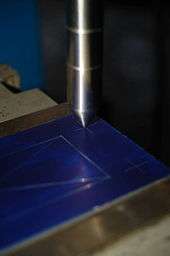Wiggler (tool)

A wiggler, edge-finder, or center-finder is a tool used in the spindle of a machine such as a mill. The device is used to accurately determine edges or markings and therefore the center of a workpiece or a previously machined feature during the set-up phase of a machining operation.
Edge finder

A rotating tool, meaning the machine spindle must be turning for the tool to work. On one edge a cylinder shape is spring-loaded; when the edge finder touches an edge, a kickoff of this cylinder is noticed. On the other end a cone shape is also spring-loaded and is used to locate the center of a previously drilled hole. This style of edge finder is considered to be the most accurate, and its accuracy can be further improved through the use of a collet. In proper setups, a repeatability of 0.0002 in (0.0051 mm) or better can be obtained.
Electronic edge finder

Sometimes also (erroneously) referred as a digital edge finder, this instrument can locate edges of work pieces and also height offsets. It works in a non-rotating spindle, which is a great advantage over its mechanical counterparts. It is battery-operated and works by lighting up its internal LED (usually red) when the electrical circuit formed by the instrument, the workpiece and the machine is closed. The light is thus illuminated when the edge finder is touching the workpiece and is visible through openings in the case. A repeatability of 0.001 in (0.025 mm) can be obtained.
Center finder

A pencil-like tool used to locate markings on stock. In contrast to the edge finder, the tip is not spring-loaded, and it works with the spindle stopped. Sometimes a magnifying glass is used to assist in marking location. Only as accurate as the lines that are drawn on the part.
External links
- Using an edge finder (video)
- Wiggler usage
- This shows you how to use a wiggler to center a rotary table.